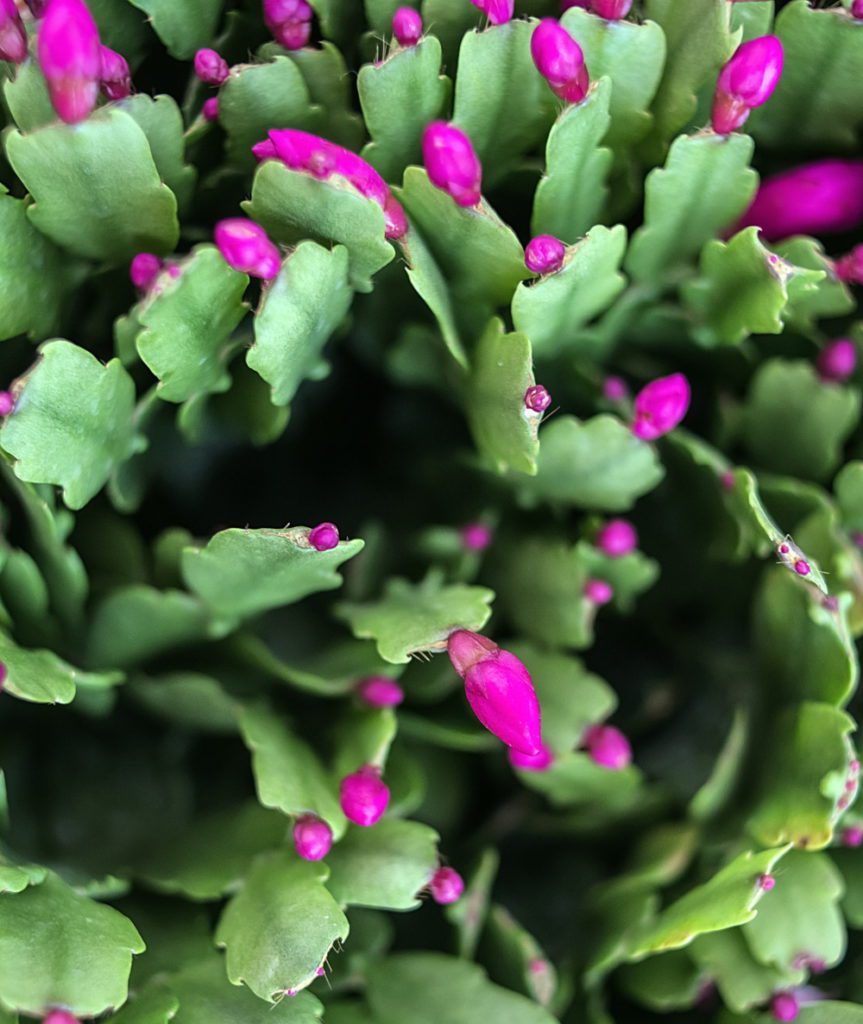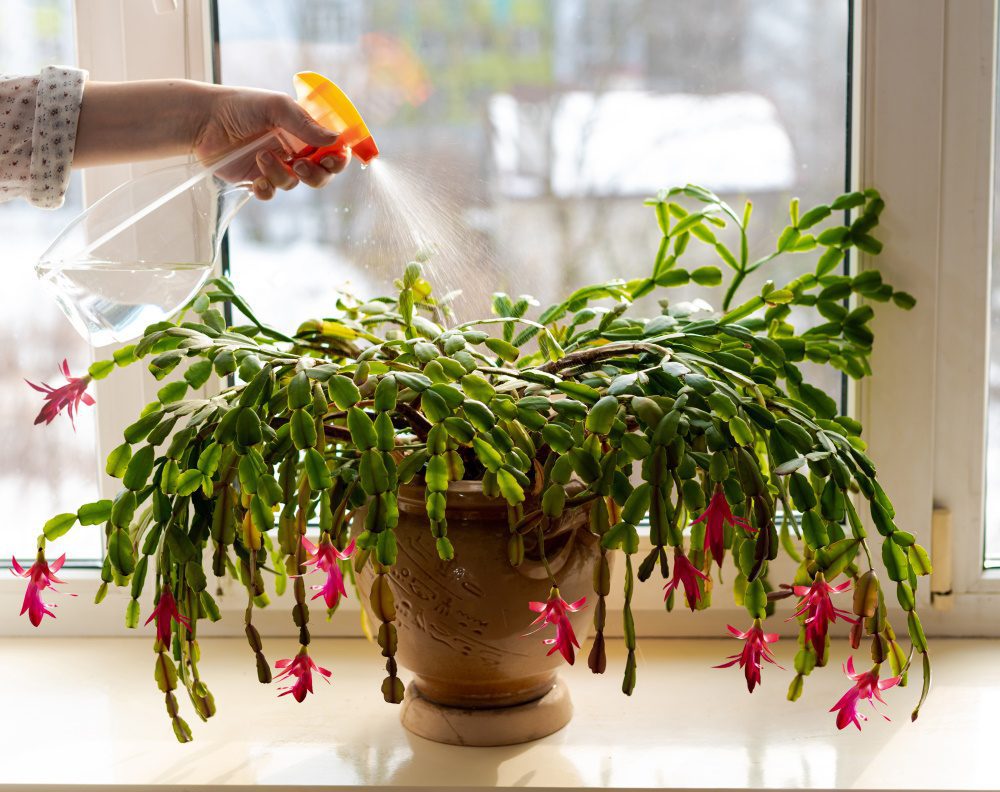
Next to the poinsettia, the Christmas cactus (genus Schlumbergera) is one of the most popular plants to give and receive during the holiday season. And for good reason – its lovely, draping blooms of red, pink, or white often appear around Thanksgiving, Christmas…or Easter.
But if it’s a “Christmas cactus,” why does it bloom in early November or in March?
The answer is simple – it’s not a Christmas cactus if it blooms at these times of the year– it’s a Thanksgiving or Easter cactus!
Confused yet? You’re not alone.
First, calling these plants cacti is a bit of a misnomer. Unlike desert cacti which are highly drought resistant, these holiday houseplants are actually succulents and they’re epiphytes – a plant that grows on top of another plant non-parasitically. Plants in the Schlumbergera family grow in and among the tree branches in the tropical rainforests of Brazil, and given their natural habitat, they require lots of water to thrive.
I have been growing two of these lovely plants for over 20 years (some Christmas cacti have been known to live for over 100 years!). Both my cacti bloom around Thanksgiving which means I actually have Thanksgiving cacti (Schlumbergia truncata), not Christmas cacti (Schlumbergera x buckleyi). Easter cacti (Schlumbergera gaertneri) blooms in the spring.
Three Types of Schlumbergera and How to Tell Them Apart
The holiday cacti of the Schlumbergera species are split into three main types. The Thanksgiving cactus, the Christmas cactus, and the Easter cactus. So how do you tell which holiday cactus you have? The most definitive way is to note the shape of the leaves. Other clues include the flower shape and the pollen color on the blooms.
The leaves of the Thanksgiving cactus are most distinct, having two to four saw-toothed serrations along the leaf margins that give them a pointy appearance that resembles crab claws. In fact, the plant is sometimes called a crab-claw cactus. The flowers of this cactus are elongated and the pollen color on the anthers is yellow.
Also, if your plant blooms in the fall between late October and November, it’s most likely a Thanksgiving cactus.

The leaves of the Schlumbergia truncata or Thanksgiving cactus, are pointed like a crab’s claw. 
The Thanksgiving cactus has elongated flowers and yellow pollen on its anthers.
The leaves of a “true” Christmas cactus have a more scalloped or tear drop shape rather than having sharp points. It also has an elongated flower, but the pollen color on the anthers is a pinkish-purple. If your cactus tends to bloom in the winter, especially around Christmas or into the New Year – then it’s most likely a Christmas cactus.

The leaves of the Schlumbergera x buckleyi, or Christmas cactus, are scalloped. 
The Christmas cactus also has elongated flowers, but its pollen pinkish-purple.
The leaves of the Easter cactus have very rounded edges and this cactus also has a more star-shaped rather than elongated flower. The Easter cactus usually blooms in the spring (although both the Thanksgiving and Christmas cactus may rebloom at this time of the year too).

The Easter cactus, Schlumbergera gaertneri , has smooth, rounded leaves and star-shaped flowers.
Christmas Cactus Plant Care
The Christmas cactus is fairly easy to care for and with a little advanced planning, you can even coax your cactus into reblooming next year, just in time for the holidays!
The Christmas cactus requires the bright light of an east or north facing window. Be careful when placing the plant in direct sunlight – at least for any length of time – as the leaves can burn (remember this is a rainforest plant!).
The Christmas cacti prefer a temperature of 68 degrees, especially when they are blooming. At this temperature, flowering can last for 6 weeks or more. But a temperature range of 60 to 70 degrees will keep them happy.
Being a native of the rainforest, this cactus likes humidity, so a regular misting is better than overwatering. Placing a few pebbles in the bottom of a plant saucer will also help add some humidity.

As a native of the Brazilian rainforest, the Schlumbergera thrives in humid conditions. Mist often to keep your plant happy!
Only water your cactus when the soil is dry to the touch, but don’t let your soil get water-logged or allow the plant to stand in water. It’s better to underwater than overwater, but remember, it’s not a desert cactus – the Christmas cactus needs regular watering.
Once the blooms fade, fertilize the plant once a month through the summer months with a water-soluble houseplant fertilizer (remember to follow the instructions for use on the fertilizer label).
When the temperatures warm up in the spring, you can move your plants outside to an area that receives dappled shade.
Christmas cactus tend to like a pot-bound growing environment and don’t often need repotting. If repotting is necessary, it’s best done in the spring. Select a container that is just slightly larger than the previous one and use a growing medium that is a mix of approximately 70 percent quality potting soil and 30 percent perlite.
To promote branching and therefore more flowers, pinch back the stems in early June.
Dormancy & Reblooming
In early September, I move my plants into the garage, where it is cool and dark so they can begin their “dormant” period. Dormancy is when plant growth and development is paused temporarily. About six to eight weeks before you want your cactus to rebloom, you should have the plant begin its dormancy cycle by cutting back on water and light and reducing the temperature.
To achieve a dormant state, the plant requires 12 to 14 hours of darkness each day and a cool, 50-degree environment. New flower buds will begin to appear within 3 to 4 weeks of dormancy. Once the buds are set, you can move the plant back into bright light and enjoy the lovely blooms!

My Thanksgiving cactus is slowly blooming in the garage after setting buds. It likes the cooler temperature and low-light environment.
The Legend of the Christmas Cactus
There is an old legend about how the Schlumbergera became known as the Christmas cactus.
A Jesuit missionary, known as Father Jose was trying to convert Bolivian natives. However, in spite of his good works and attempts to pass along the Word, he was met with failure. The native people appreciated his help but did not believe in the Christmas story.
As he was praying at his crude alter on Christmas eve, he heard the congregants singing a hymn he had taught them. He turned to see the children heading his way carrying plant stems decorated with beautiful flowers. These were the blooms of the Schlumbergera cacti, which they gave to him to decorate the altar.
And thus the “Christmas” cactus came to be. True or not – it’s a wonderful tale!









[…] Click to read more about Christmas Cacti and see photos! […]